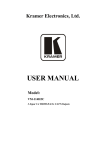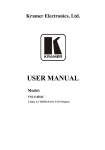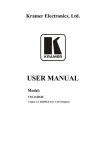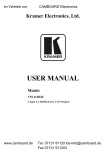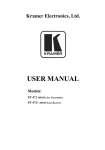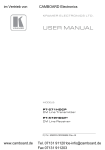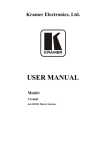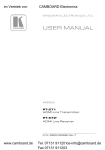Download USER MANUAL
Transcript
Kramer Electronics, Ltd. USER MANUAL Model: VM-114H 2x Input 1:4 HDMI DA Contents Contents 1 2 2.1 2.2 2.3 2.4 3 3.1 3.2 4 5 5.1 5.2 5.3 Introduction Getting Started Achieving the Best Performance Safety Instructions Recycling Kramer Products Quick Start Overview Using Shielded Twisted Pair Cable About the Power Connect™ Feature Defining the VM-114H 2 Input 1:4 HDMI DA Using the VM-114H 2 Input 1:4 HDMI DA Connecting the VM-114H 2 Input 1:4 HDMI DA Selecting an Active Input Acquiring the EDID 5.3.1 Disabling/Enabling Deep Color Support 5.4 6 7 8 9 10 Connecting to the VM-114H via RS-232 Wiring the Twisted Pair RJ-45 Connectors Technical Specifications Default Communication Parameters Default EDID Kramer Protocol 2000 1 1 1 2 2 2 3 4 5 6 7 7 8 8 9 10 10 11 11 12 13 Figures Figure 1: VM-114H 2 Input 1:4 HDMI DA Front and Rear Panels Figure 2: Connecting the VM-114H 2 Input 1:4 HDMI DA Figure 3: TP Pinout Wiring 6 8 10 Tables Table 1: VM-114H 2 Input 1:4 HDMI DA Front and Rear Panel Features Table 2: Technical Specifications of the VM-114H Table 3: Default Communication Parameters Table 4: Protocol Definitions Table 5: Instruction Codes for Protocol 2000 6 11 11 13 14 i Introduction 1 Introduction Welcome to Kramer Electronics! Since 1981, Kramer Electronics has been providing a world of unique, creative and affordable solutions to the vast range of problems that confront the video, audio, presentation and broadcasting professional on a daily basis. In recent years, we have redesigned and upgraded most of our line, making the best even better! Our 1,000-plus different models now appear in 11 groups 1 that are clearly defined by function. Congratulations on purchasing your Kramer VM-114H 2 Input 1:4 HDMI DA. The VM-114H is ideal for: • Home theater, presentation and multimedia applications • Rental and staging The package includes the following items: • VM-114H 2 Input 1:4 HDMI DA • Power adapter (12V DC) • Kramer RC-IR3 infrared remote control transmitter (including the required batteries and a separate user manual2) • This user manual 2 2 Getting Started We recommend that you: • Unpack the equipment carefully and save the original box and packaging materials for possible future shipment • Do not secure the cables in tight bundles or roll the slack into tight coils • Review the contents of this user manual 2.1 Achieving the Best Performance To achieve the best performance: • Use only good quality connection cables (we recommend Kramer highperformance, high-resolution cables) to avoid interference, deterioration in signal quality due to poor matching, and elevated noise levels (often associated with low quality cables) 1 GROUP 1: Distribution Amplifiers; GROUP 2: Switchers and Routers; GROUP 3: Control Systems; GROUP 4: Format/Standards Converters; GROUP 5: Range Extenders and Repeaters; GROUP 6: Specialty AV Products; GROUP 7: Scan Converters and Scalers; GROUP 8: Cables and Connectors; GROUP 9: Room Connectivity; GROUP 10: Accessories and Rack Adapters; GROUP 11: Sierra Products 2 Download up-to-date Kramer user manuals from http://www kramerelectronics com 1 Getting Started • Do not secure the cables in tight bundles or roll the slack into tight coils • Avoid interference from neighboring electrical appliances that may adversely influence signal quality • Position your Kramer VM-114H away from moisture, excessive sunlight and dust ! 2.2 Safety Instructions ! 2.3 This equipment is to be used only inside a building. It may be connected only to other equipment that is installed inside a building. Caution: No operator serviceable parts inside the unit Warning: Use only the Kramer Electronics input power wall adapter that is provided with the unit. Warning: Disconnect the power and unplug the unit from the wall before installing Recycling Kramer Products The Waste Electrical and Electronic Equipment (WEEE) Directive 2002/96/EC aims to reduce the amount of WEEE sent for disposal to landfill or incineration by requiring it to be collected and recycled. To comply with the WEEE Directive, Kramer Electronics has made arrangements with the European Advanced Recycling Network (EARN) and will cover any costs of treatment, recycling and recovery of waste Kramer Electronics branded equipment on arrival at the EARN facility. For details of Kramer’s recycling arrangements in your particular country go to our recycling pages at http://www.kramerelectronics.com/support/recycling/. 2.4 Quick Start This quick start chart summarizes the basic setup and operation steps of the VM-114H. 2 KRAMER: SIMPLE CREATIVE TECHNOLOGY Overview 3 Overview The high quality VM-114H 2 Input 1:4 HDMI DA is a switcher/distribution amplifier for HDMI and TP (Twisted Pair) signals. It reclocks and equalizes one of two selectable input signals and distributes it to four identical HDMI outputs. 3 Overview In particular, the VM-114H: • Has a maximum data rate of 2.25Gbps bandwidth per graphic channel (HDMI), 1.65Gbps bandwidth per graphic channel (DGKat) • Can read and store, in non-volatile memory, the default EDID, or the EDID 1 block from one or a mix 2 of the output display devices, so it can then provide the EDID information to the source even if the display device is not connected • Features I-EDIDPro™ Kramer Intelligent EDID Processing™ – Intelligent EDID handling & processing algorithm ensures Plug and Play operation for HDMI systems • Supports 3D Pass-through, Deep Color 3, x.v.Color™ and uncompressed audio channels (Dolby TrueHD, DTS-HD) • Is HDCP compliant • Features LEDs indicating the selected input and active output • Supports IR remote control • Is 12V DC fed and is housed in a Kramer desktop enclosure The VM-114H supports a range of: • Up to 90m (295ft) at 1080i, or up to 30m (98ft) at 1080p on shielded BC-DGKat524 cable • Up to 90m (295ft) at 1080i, or up to 70m (230ft) at 1080p on shielded BC-DGKat623 cable • Up to 100m (330ft) at 1080i or up to 90m (295ft) at 1080p on shielded BC-DGKat7a23 cable You can daisy-chain up to six devices with the maximum overall distance between the first and last devices being cumulative and limited by the cable type used. 3.1 Using Shielded Twisted Pair Cable Kramer engineers have developed special twisted pair cables to best match our digital twisted pair products; the Kramer: BC-DGKat524 (CAT 5 24 AWG), the Kramer BC-DGKat623 (CAT 6 23 AWG), and the Kramer BC-DGKat7a23 (CAT 7a 23 AWG) cables. These specially built cables significantly outperform regular CAT 5/CAT 6 /CAT 7a cables. 1 EDID is Extended Display Identification Data (see Section 3 3 for a more detailed definition) 2 The EDID acquired is a weighted average of all the connected outputs For example, if several displays with different resolutions are connected to the outputs, the acquired EDID supports all the resolutions, as well as other parameters included in the EDID 3 On the HDMI input 4 KRAMER: SIMPLE CREATIVE TECHNOLOGY Overview 3.2 About the Power Connect™ Feature The Power Connect™ feature here means that only the transmitter needs to be connected to a power source when the devices are within 90m (270ft) of each other. The Power Connect™ feature applies as long as the cable can carry power. The distance does not exceed 90m on standard CAT 5 cable. For longer distances, heavier gauge cable should be used 1. ! Warning: Using a TP cable that is incorrectly wired will cause permanent damage to the device 1 CAT 5 cable is still suitable for the video/audio transmission, but not for feeding the power at these distances 5 Defining the VM-114H 2 Input 1:4 HDMI DA 4 Defining the VM-114H 2 Input 1:4 HDMI DA Figure 1 and Table 1 define the front and rear panels of the VM-114H 2 Input 1:4 HDMI DA. Figure 1: VM-114H 2 Input 1:4 HDMI DA Front and Rear Panels Table 1: VM-114H 2 Input 1:4 HDMI DA Front and Rear Panel Features # 4 Feature IR Remote Control Sensor IR LED READ Button EDID Buttons SELECT Button 5 OUTPUT 1~4 LEDS 6 7 8 POWER LED Lights green when he unit receives power INPUT SELECTOR Button Press to select an input. The relevant input LED lights IN1 HDMI LED Lights green when he HDMI input 1 is selected Input 1 2 3 Function Sensor for the remote control IR transmitter Lights yellow when receiving signals from the IR remote control transmitter Press (when one of the input LEDs is flashing to indicate a selected input) to read the selected EDID (see Section 5.2) Press repeatedly to cycle through the inputs to select an input from which to read the EDID. The relevant LED flashes (see Section 5.2) The relevant LED lights green when an acceptor is connected to the output 1 1 Also lights or flashes during EDID setup (see Section 5 2) 6 KRAMER: SIMPLE CREATIVE TECHNOLOGY Using the VM-114H 2 Input 1:4 HDMI DA # 9 10 11 12 13 14 5 Feature LEDs IN2 CAT5 LED RS-232 9-pin D-sub (F) Connector 12V DC Power Connector IN1 (HDMI) Input HDMI Connector Inputs IN2 (CAT5) Input RJ-45 Connector OUT 1 OUT 2 HDMI OUTPUTS OUT 3 OUT 4 Function Lights green when he TP CAT 5 input 2 is selected Connect to a PC or remote controller Connect to he +12V DC power adapter, center pin posi ive Connect to an HDMI source Connect to a TP CAT 5 source (for example, PT-571 HDMI Line Transmitter, VM-114H2C or VM-114H4C) Connect to he HDMI acceptors Using the VM-114H 2 Input 1:4 HDMI DA This section describes how to connect the VM-114H (see Section 5.1), how to acquire the EDID (see Section 5.2) and how to connect via RS-232 (see Section 5.4). 5.1 Connecting the VM-114H 2 Input 1:4 HDMI DA To connect 1 the VM-114H as illustrated in the example in Figure 2: 1. Connect the HDMI source (for example, a DVD player) to the IN 1 (HDMI) connector. 2. Connect the CAT 5 TP source (for example, a PT-571 HDMI Line Transmitter, VM-114H2C or VM-1114H4C) to the IN 2 (CAT5) connector. 3. Connect the HDMI OUT connectors to up to four HDMI display devices (for example, plasma displays or LCD TVs) 4. (Optional) Connect a PC via RS-232 to the RS-232 port on the VM-114H (see Section 5.4). 5. Connect the power adapter to the power socket on the VM-114H and to the mains electricity. 6. (Optional) Press the EDID READ button to acquire or change the EDID information (see Section 5.2). 1 Switch OFF the power on each device before connecting it to your VM-114H After connecting your VM-114H, switch on its power and then switch on the power on each device 7 Using the VM-114H 2 Input 1:4 HDMI DA Figure 2: Connecting the VM-114H 2 Input 1:4 HDMI DA 5.2 Selecting an Active Input To select an active input: • Press the INPUT SELECTOR button until the required INPUT LED lights 5.3 Acquiring the EDID Each input on the VM-114H has a factory default EDID loaded 1 (see Section 8). This lets you connect the power before having to connect one of the acceptors. You can acquire the EDID 2 from: • One output (the relevant output LED flashes) • The default EDID (all output LEDs flash) • Up to four connected outputs using the Auto-mix Mode 1 (all output LEDs light) 1 The VM-114H reads the EDID which is stored in the non-volatile memory 2 This is usually done only once when the machine is being set up in an installation Once acquired, the EDID is saved in non-volatile memory and further acquisition is not necessary 8 KRAMER: SIMPLE CREATIVE TECHNOLOGY Using the VM-114H 2 Input 1:4 HDMI DA To acquire the EDID: 1. Connect the output(s) from which you want to acquire the EDID. 2. Press the EDID SELECT button briefly. The device enters the EDID programming mode. The last acquired EDID is indicated by the lit LED (for example, if Output LED 2 is lit, the EDID acquired was from Output 2). 3. Press the EDID SELECT button repeatedly until the required EDID is indicated based on the patterns described above. 4. Press the EDID READ button. The relevant LEDs flash in a pattern for a few seconds as follows: Slowly and then no longer lights. The EDID was successfully read. Quickly and then no longer lights. The EDID was not read and the default EDID was stored. 5.3.1 Disabling/Enabling Deep Color Support You can disable EDID deep color support to prevent signal deterioration when using long twisted pair cables on INPUT 2. To disable deep color and acquire EDID: 1. Disconnect the power. 2. Connect the output or outputs from which you want to acquire the EDID. 3. Connect the power while pressing the EDID READ button. 4. Perform steps 3 through 5 in Section 5.3. To enable deep color and acquire EDID: 1. Disconnect the power. 2. Connect the output or outputs from which you want to acquire the EDID. 3. Connect the power while pressing the EDID SELECT button. 4. Perform steps 3 through 5 in Section 5.3. 1 The EDID acquired is a weighted average of all the connected outputs For example, if several displays with different resolutions are connected to the outputs, the acquired EDID supports all the resolutions, as well as other parameters included in the EDID 9 Wiring the Twisted Pair RJ-45 Connectors 5.4 Connecting to the VM-114H via RS-232 You can connect to the VM-114H via an RS-232 connection using, for example, a PC. Note that a null-modem adapter/connection is not required. To connect to the VM-114H via RS-232: • Connect the RS-232 9-pin D-sub rear panel port on the product unit via a 9-wire straight cable (only pin 2 to pin 2, pin 3 to pin 3, and pin 5 to pin 5 need to be connected) to the RS-232 9-pin D-sub port on your PC 6 Wiring the Twisted Pair RJ-45 Connectors When using STP cable, connect/solder the cable shield to the RJ-45 connector shield. Figure 3 defines the TP pinout using a straight pin-to-pin cable with RJ-45 connectors. i Note, that the cable Ground shielding must be connected/soldered to the connector shield. EIA /TIA 568B 10 PIN 1 Wire Color Orange / White 2 Orange 3 Green / White 4 Blue 5 Blue / White 6 Green 7 8 Brown / White Brown Pair 1 4 and 5 Pair 2 1 and 2 Pair 3 3 and 6 Pair 4 7 and 8 Figure 3: TP Pinout Wiring KRAMER: SIMPLE CREATIVE TECHNOLOGY Technical Specifications 7 Technical Specifications Table 2 includes the technical specifications 1 of the VM-114H. Table 2: Technical Specifications of the VM-114H INPUTS: 1 HDMI Connector 1 CAT 5 RJ-45 Connector 4 HDMI Connectors Up to 2.25Gbps bandwidth per graphic channel (HDMI), 1.65Gbps bandwidth per graphic channel (DGKat) Supports HDMI and HDCP OUTPUTS: BANDWIDTH: COMPLIANCE WITH HDMI STANDARD: CONTROLS: INDICATOR LEDs: POWER CONSUMPTION: OPERATING TEMPERATURE: STORAGE TEMPERATURE: HUMIDITY: D MENSIONS: WEIGHT: ACCESSORIES: OPTIONS: 8 Input select button, EDID select button, panel lock button IR communication, Power, IN 1(HDMI), IN 2 (CAT5), OUTPUT 1, 2, 3 and 4 12V DC, 0 5A 0° to +40°C (32° to 104°F) –40° to +70°C (–40° to 158°F) 10% to 90%, RHL non-condensing 21.5cm x 16.3cm x 4.4cm (8.5in x 6.4in x 1.7in) W, D, H 0.9kg (1.98lbs) approx. Power supply, RC-IR3 infrared remote control transmitter HDMI/HDMI male-to-male cables, RK-1 19” rack adapter Default Communication Parameters Table 3 lists the default communication parameters for the VM-114H. Table 3: Default Communication Parameters RS-232 Protocol 2000 Baud Rate: Data Bits: Stop Bits: Parity: Command Format: Example (Output 1 to Input 1): 9600 8 1 None HEX 0x01, 0x81, 0x81, 0x81 1 Specifications are subject to change without notice 11 Default EDID 9 Default EDID The factory default EDID is listed below. Monitor Model name............... VM114H Manufacturer............. KRM Plug and Play D......... KRM0114 Serial number............ 505-707455010 Manufacture date......... 2009, ISO week 10 ------------------------EDID revision............ 1 3 Input signal type........ Digital Color bit depth.......... Undefined Display type............. RGB color Screen size.............. 520 x 320 mm (24 0 in) Power management......... Standby, Suspend, Active off/sleep Extension blocs.......... 1 (CEA-EXT) ------------------------DDC/CI................... n/a Color characteristics Default color space...... Non-sRGB Display gamma............ 2.20 Red chromaticity......... Rx 0 674 - Ry 0.319 Green chromaticity....... Gx 0.188 - Gy 0.706 Blue chromaticity........ Bx 0.148 - By 0 064 White point (default).... Wx 0 313 - Wy 0.329 Additional descriptors... None Timing characteristics Horizontal scan range.... 30-83kHz Vertical scan range...... 56-76Hz Video bandwidth.......... 170MHz CVT standard............. Not supported GTF standard............. Not supported Additional descriptors... None Preferred timing......... Yes Native/preferred timing.. 1280x720p at 60Hz (16:10) Modeline............... "1280x720" 74.250 1280 1390 1430 1650 720 725 730 750 +hsync +vsync Standard timings supported 720 x 400p at 70Hz - BM VGA 640 x 480p at 60Hz - BM VGA 640 x 480p at 75Hz - VESA 800 x 600p at 60Hz - VESA 800 x 600p at 75Hz - VESA 1024 x 768p at 60Hz - VESA 1024 x 768p at 75Hz - VESA 1280 x 1024p at 75Hz - VESA 1280 x 1024p at 60Hz - VESA STD 1600 x 1200p at 60Hz - VESA STD 1152 x 864p at 75Hz - VESA ST 12 KRAMER: SIMPLE CREATIVE TECHNOLOGY Kramer Protocol 2000 10 Kramer Protocol 2000 This RS-232 communication protocol uses four bytes of information as defined below. The default data rate is 9600 baud, with no parity, 8 data bits and 1 stop bit. Table 4: Protocol Definitions MSB LSB DESTINATION INSTRUCTION 0 D N5 N4 N3 N2 N1 N0 7 6 5 4 3 2 1 0 1st byte INPUT 1 6 I5 I4 I3 I2 I1 I0 7 6 5 4 3 2 1 0 2nd byte OUTPUT 1 O6 O5 O4 O3 O2 O1 O0 7 6 5 4 3 2 1 0 1 OVR X M4 M3 M2 M1 M0 7 6 5 4 3 2 1 0 3rd byte MACHINE NUMBER 4th byte 1st BYTE: Bit 7 – Defined as 0 D – “DESTINATION”: 0 - for sending information to the switchers (from the PC); 1 - for sending to the PC (from the switcher) N5 N0 – “INSTRUCTION” The function that is to be performed by the switcher(s) is defined by the INSTRUCTION (6 bits) Similarly, if a function is performed via the machine’s keyboard, then these bits are set with the INSTRUCTION NO , which was performed The instruction codes are defined according to the table below (INSTRUCTION NO is the value to be set for N5 N0) 2nd BYTE: Bit 7 – Defined as 1 I6 I0 – “INPUT” When switching (ie instruction codes 1 and 2), the INPUT (7 bits) is set as the input number which is to be switched Similarly, if switching is done via the machine’s front-panel, then these bits are set with the INPUT NUMBER which was switched For other operations, these bits are defined according to the table 3rd BYTE: Bit 7 – Defined as 1 O6 O0 – “OUTPUT” When switching (ie instruction codes 1 and 2), the OUTPUT (7 bits) is set as the output number which is to be switched Similarly, if switching is done via the machine’s front-panel, then these bits are set with the OUTPUT NUMBER which was switched For other operations, these bits are defined according to the table 4th BYTE: Bit 7 – Defined as 1 Bit 5 – Don’t care OVR – Machine number override M4 M0 – MACHINE NUMBER Used to address machines in a system via their machine numbers When several machines are controlled from a single serial port, they are usually configured together with each machine having an individual machine number If the OVR bit is set, then all machine numbers will accept (implement) the command, and the addressed machine will reply For a single machine controlled via the serial port, always set M4 M0 = 1, and make sure that the machine itself is configured as MACHINE NUMBER = 1 13 Kramer Protocol 2000 Table 5: Instruction Codes for Protocol 2000 Note: All values in the table are decimal, unless otherwise stated INSTRUCTION DEFINITION FOR SPECIFIC INSTRUCTION # INPUT 1 61 62 DESCRIPTION SWITCH V DEO IDENTIFY MACH NE DEFINE MACHINE NOTE OUTPUT Set equal to video input which is to be switched (0 = disconnect) Set equal to video output which is 2 to be switched (0 = to all the outputs) 1 - video machine name 3 - video software version 9 - protocol 2000 version 0 - Request first 4 digits 1 - Request first suffix 2 - Request second suffix 3 - Request third suffix 10 - Request first prefix 11 - Request second prefix 12 - Request third prefix 13 1 - number of inputs 2 - number of outputs 1 - for video 2 - for audio 14 NOTES on the above table: NOTE 2 - These are bi-directional definitions That is, if the switcher receives the code, it will perform the instruction; and if the instruction is performed (due to a keystroke operation on the front panel), then these codes are sent For example, if the HEX code 01 85 88 83 was sent from the PC, then the switcher (machine 3) will switch input 5 to output 8 If the user switched input 1 to output 7 via the front panel keypad, then the switcher will send HEX codes: 41 81 87 83 to the PC When the PC sends one of the commands in this group to the switcher, then, if the instruction is valid, the switcher replies by sending to the PC the same four bytes that it was sent (except for the first byte, where the DESTINATION bit is set high) NOTE 13 - This is a request to identify the switcher/s in the system If the OUTPUT is set as 0, and the INPUT is set as 1, 2, 5 or 7, the machine will send its name The reply is the decimal value of the INPUT and OUTPUT For example, for a 2216, the reply to the request to send the audio machine name would be (HEX codes): 7D 96 90 81 (i e 128dec+ 22dec for 2nd byte, and 128dec+ 16dec for 3rd byte) If the request for identification is sent with the INPUT set as 3 or 4, the appropriate machine will send its software version number Again, the reply would be the decimal value of the INPUT and OUTPUT - the INPUT representing the number in front of the decimal point, and the OUTPUT representing the number after it For example, for version 3 5, the reply to the request to send the version number would be (HEX codes): 7D 83 85 81 (i e 128dec+ 3dec for 2nd byte, 128dec+ 5dec for 3rd byte) If the OUTPUT is set as 1, then the ASCII coding of the lettering following the machine’s name is sent For example, for the VS7588YC, the reply to the request to send the first suffix would be (HEX codes): 7D D9 C3 81 (i e 128dec+ ASCII for “Y”; 128dec+ ASCII for “C”) NOTE 14 - The number of inputs and outputs refers to the specific machine which is being addressed, not to the system For example, if six 16X16 matrices are configured to make a 48X32 system (48 inputs, 32 outputs), the reply to the HEX code 3E 82 81 82 (ie request the number of outputs) would be HEX codes 7E 82 90 82 ie 16 outputs 14 KRAMER: SIMPLE CREATIVE TECHNOLOGY For the latest information on our products and a list of Kramer distributors, visit www.kramerelectronics.com where updates to this user manual may be found. We welcome your questions, comments and feedback. Safety Warning: Disconnect the unit from the power supply before opening/servicing. Caution P/N: 2900- 000643 Rev: 8 Web site: www kramerelectronics.com E-mail: [email protected] P/N: 2900-000643 REV 8




















